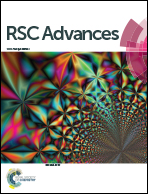Highly coplanar bis(thiazol-2-yl)-diketopyrrolopyrrole based donor–acceptor copolymers for ambipolar field effect transistors†
Abstract
The coplanarity and intermolecular interactions of polymers are fundamental factors influencing intra- or interchain charge transport for polymer field-effect transistors (PFETs). In this work, four alternating donor–acceptor copolymers with the acceptor of bis(thiazol-2-yl)-diketopyrrolopyrrole (TZDPP) and donor of (E)-1,2-di(thiophen-2-yl)ethene (TVT) or (E)-1,2-di(selenophen-2-yl)ethene (SVS) were synthesized. The introduction of thiazole units promotes the coplanarity of the polymer backbone. In addition, the electron deficient properties of TZDPP enhance interchain interactions. The polymers exhibited ambipolar semiconducting behaviours with the highest hole and electron mobilities reaching 0.17 and 9.7 × 10−3 cm2 V−1 s−1, respectively, in top-gate bottom-contact PFET devices. The SVS-based polymers showed lower mobilities than those containing TVT units. Careful characterization of the polymer films revealed that though the polymers containing SVS units exhibited better crystallinity, their films were less ordered and less uniform, which may arise from the limited solubility of the polymers. These results suggest the critical role of solubility in the fabrication of devices, and the interchain interactions should be controlled in an appropriate manner.


 Please wait while we load your content...
Please wait while we load your content...